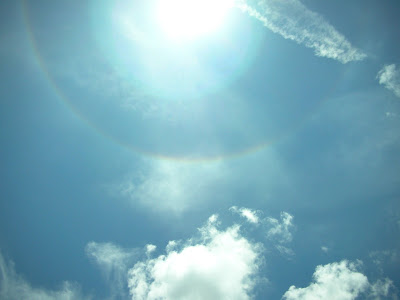Video Transcript:
What’s Up for October? The Andromeda Galaxy!
十月星空:仙女星系
Hello and welcome. I'm Jane Houston Jones at NASA's Jet Propulsion Laboratory in Pasadena, California.
2009 is the International Year of Astronomy. And every month this year we’ll be showcasing a great celestial view. This month it’s the Andromeda Galaxy!
When you look up at the October sky you’ll easily see solar system objects like Jupiter and the moon. You can also see stars, clumps and knots of nebulosity in our Milky Way Galaxy.
But did you know you can actually see another galaxy with your own eyes, even without a telescope? The Andromeda Galaxy is the most distant easily visible object in the sky, and it’s also the largest and closest spiral galaxy that we can see. It’s visible even under moderate light polluted skies as a misty patch. Through binoculars and telescopes more and more detail is revealed to the observer.
不過,你知道嗎?不需要望遠鏡,只用肉眼就可以看到我們銀河系的鄰居,另一個銀河系,(應該稱為「星系」,「銀河」指的是我們太陽系所在的星系) 那就是「仙女星系」,就在十月的星空! 它是天空中我們可以輕易看到的最遠物體,同時也是我們可以看大的最大、最近的螺旋星系,即使是中度光汙染的天空也看得見。當然,透過雙筒望遠鏡或天文望遠鏡,就可以看得更仔細。
Astronomers have observed the Andromeda galaxy for over a thousand years. Persian astronomer Al-Sufi was the first to record and sketch his observations of what he called “the little cloud”. In 964 he published this observation and many others in his “Book of Fixed Stars”.
天文學家觀察仙女星系已經超過一千年,波斯的天文學家蘇菲 (Al-Sufi) 就是觀測紀錄並描繪這個他所謂「小雲 (the little cloud)」的第一人,天邊那朵「小雲」就收錄在他西元964年出版的「恆星之書 (Book of Fixed Stars)」中。
Since the 16th century many astronomers rediscovered the Andromeda Galaxy unaware of the earlier sightings. Simon Marius first viewed the galaxy through a telescope in 1612.
It is also known as M-31 on Charles Messier’s list of objects, although he was aware of some earlier sightings.
仙女星系後來經梅西爾 (Charles Messier) 再度觀測,並編列在梅西爾星表中,編號M-31。
In 1887 the first photograph revealed the spiral structure of the Andromeda Galaxy, which was then known as a nebula. And in the early 20th century Edwin Hubble’s study of Andromeda nebula proved the nebula was not just a star cluster in our own Milky Way, but a separate galaxy.
NASA's Swift satellite recently acquired the highest-resolution view of a neighboring spiral galaxy ever attained in ultraviolet wavelengths. Swift revealed about 20,000 ultraviolet sources in the Andromeda Galaxy, especially hot, young stars and dense star clusters.
NASA’s Spitzer Space Telescope, Galaxy Evolution Explorer and Chandra X-Ray Observatory also observed the Andromeda Galaxy in infrared, ultraviolet and X-ray wavelengths.
In addition to the Andromeda Galaxy, you can still catch a great view of our Milky Way galaxy this month. Both are nearly overhead, but while distant Andromeda is seen as a fuzzy oval in the constellation Andromeda, the Milky Way spans the sky from east to overhead to the west. It’s a gorgeous site from a dark sky again this month.
Back to our solar system, Jupiter reigns as king of the planets in the western sky and Mars will rise before midnight by the end of the month, making it a late night pumpkin-colored treat on Halloween.
回到我們的太陽系,木星這個月仍然稱霸西方天空,火星在本月底午夜會從東方升起,為萬聖節的深夜添抹南瓜色彩。
That’s all for this month, I’m Jane Houston Jones.
Find this article at:
請參考下列網頁以獲得更多資訊:
- M31: The Andromeda Galaxy
http://antwrp.gsfc.nasa.gov/apod/ap080124.html
http://antwrp.gsfc.nasa.gov/apod/ap040718.html - M31: 仙女星系
http://www.phys.ncku.edu.tw/~astrolab/mirrors/apod/ap080124.html
http://www.phys.ncku.edu.tw/~astrolab/mirrors/apod/ap040718.html - Galaxy
http://en.wikipedia.org/wiki/Galaxy - 星系
http://zh.wikipedia.org/zh-tw/星系 - Milky Way
http://en.wikipedia.org/wiki/Milky_way
http://apod.nasa.gov/apod/ap090926.html
http://apod.nasa.gov//apod/ap090729.html - 銀河
http://zh.wikipedia.org/zh-tw/銀河系
http://www.phys.ncku.edu.tw/~astrolab/mirrors/apod/ap090926.html
http://www.phys.ncku.edu.tw/~astrolab/mirrors/apod/ap090729.html - Al-Sufi
http://en.wikipedia.org/wiki/Al_Sufi - 蘇菲
http://www.jhjh.cyc.edu.tw/student/93/301/30116/html/c.htm#蘇菲 - Simon Marius
http://en.wikipedia.org/wiki/Simon_Marius - 西門·馬里烏斯
http://zh.wikipedia.org/zh-tw/西門·馬里烏斯 - Charles Messier
http://en.wikipedia.org/wiki/Charles_Messier - 查理斯·梅西爾
http://zh.wikipedia.org/zh-tw/夏尔·梅西耶 - Charles Messier’s list of objects
http://en.wikipedia.org/wiki/Messier_object - 梅西爾星表
http://zh.wikipedia.org/zh-tw/梅西耶天體
http://aeea.nmns.edu.tw/aeea/contents_list/messier.html - Nebula
http://en.wikipedia.org/wiki/Nebula - 星雲
http://zh.wikipedia.org/zh-tw/星雲 - Edwin Hubble
http://en.wikipedia.org/wiki/Edwin_Hubble - 愛德溫·哈伯
http://zh.wikipedia.org/zh-tw/愛德溫·哈伯 - Star Cluster
http://en.wikipedia.org/wiki/Star_cluster - 星團
http://zh.wikipedia.org/zh-tw/星團 - Swift Satellite
http://heasarc.gsfc.nasa.gov/docs/swift/swiftsc.html
http://en.wikipedia.org/wiki/Swift_Gamma-Ray_Burst_Mission - 史威福觀測衛星
http://zh.wikipedia.org/zh-tw/雨燕衛星 - Spitzer Space Telescope
http://www.nasa.gov/mission_pages/spitzer/main/index.html
http://en.wikipedia.org/wiki/Spitzer_Space_Telescope - 史匹哲太空望遠鏡
http://zh.wikipedia.org/zh-tw/史匹哲太空望遠鏡 - Galaxy Evolution Explorer
http://www.nasa.gov/mission_pages/galex/index.html
http://en.wikipedia.org/wiki/GALEX - 星系演化探索者號
http://zh.wikipedia.org/zh-tw/星系演化探測器 - Chandra X-Ray Observatory
http://www.nasa.gov/mission_pages/chandra/main/index.html
http://en.wikipedia.org/wiki/Chandra_X-Ray_Observatory - 錢卓X光太空天文台
http://zh.wikipedia.org/zh-tw/錢德拉X射線天文台 - Amazing Andromeda Galaxy
http://www.nasa.gov/centers/jpl/news/spitzerf-20061003.html - Infrared Andromeda
http://apod.nasa.gov/apod/ap070721.html
http://apod.nasa.gov/apod/ap060609.html - 紅外線波段的仙女星系
http://www.phys.ncku.edu.tw/~astrolab/mirrors/apod/ap070721.html
http://www.phys.ncku.edu.tw/~astrolab/mirrors/apod/ap060609.html - Ultraviolet Andromeda
http://apod.nasa.gov/apod/ap090917.html - 紫外光波段的仙女座大星系
http://www.phys.ncku.edu.tw/~astrolab/mirrors/apod/ap090917.html - The Evening Skymap October 2009
http://www.skymaps.com/skymaps/tesmn0910.pdf - 2009十月星圖
http://163.29.36.87/AP_Data/Message/3790000000/379040000E/379041700E/.message/20081/18/47904b04:4397/4ac56d5a.pdf






 日暈現高雄
日暈現高雄
